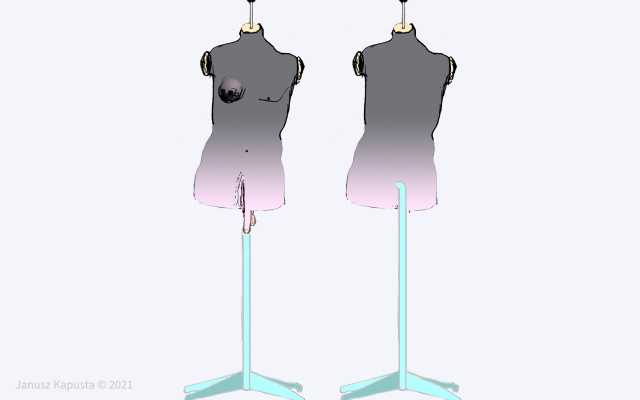Feminism, false compulsion of equality and fashion for homosexuality
Significant anatomical and psychological differences between women and men are characteristics that we are to acknowledge as the most valuable from what nature bestowed on us. This gift was not just unrecognised but also has become a target of attacks from multiple sides. For the first time in history, we decided to affect the balance that nature worked out for all living beings and we attempt to eliminate or, at least, reduce the differentiating gender characteristics.
Why has such a radical turn occurred, what caused it and what does it tell us about the times we live in? Why our civilisation consciously kneel before fashion’s dictate that emasculates men and draws masculine traits out of women? (…)
The easiest explanation is, of course, the fact that we are witnessing effects of contemporary, radical change of tastes – such changes can be traced in the history of culture, fashion and art. Previous generations lived in times of hardship and uncertainty, therefore an ideal of womanhood and health was expressed through full figure. Contrary to this, today we live in wealth and prosperity that encourages forming a totally opposite ideal.
Furthermore, some significance could be assigned to the tiredness and saturation effect resulting from post-war cult of full-figured and ample-bosomed women such as Marylin Monroe or Bridget Bardot. It is impossible to forget about political Left rising in the sixties’ Europe, rebelling against society’s view of woman’s curviness being the bourgeois beauty cannon. Yet even in the case of such a radical turn, there has to be different, far more important reasons. The key to understand what happened in the recent past is, in my opinion, the distorted idea of equality under the mantle of which the ideal of two equally important genders became a monstrous, ideological concept of two identical genders.
Radical feminists, on the tide of fighting for equal right’s enthusiasm, added a demand for abolishing all differences between women and men. Though what was understood as equality and identity began to switch places in order to be called inequality later on. Men and women are equal, therefore everything that is different between them is, from the doctrine’s perspective, perceived as undesirable.
As a matter of principle, i.e.: the same wage, the same privileges and or economic and sexual freedom, differences were eliminated everywhere they occurred – in behaviour, duties, one’s tastes and fashion trends. An expression of said process is exemplified by so called unisex fashion that made its debut in the sixties. Nowadays, with rare exceptions and in occasional celebrations, we wear the same jeans and sweaters. The same laws concern us all, the same work responsibilities, the same brain and so does the unisex clothing – the body comes next. Primarily legitimate equality idea was, eventually, like always in the history of humankind, twisted resulting in such absurdity that it became unbearable and dangerous caricature of itself. To promote unification in matters of taste, the “most professional specialists” were up for the challenge, radicalising the trend and gradually creating most eccentric extremes within it. The contemporary cult of women thinness was born among members of so called LGBT community (gay, lesbian, bi-sexual and trans-gender people), to hold onto the current terminology, from where it was being steadily grafted as a trend for the whole western society.
It is a well-known fact, that homosexualism adds sensitivity to men, giving them opportunity to be part of the dialogue with women in such topics as life decorum, interior design, hairdressing, women fashion and design – areas where they have already gained their almost monopoly position. Circles responsible for top fashion design were always and still are overrepresented by homosexuals who call the shots in the whole industry, whereas a list of influential fashion designers connected to LGBT movement, both in the past and presently, is really astonishing[1].
At the end of 2013, New York’s Fashion Institute of Technology organised an exhibition entitled “Queer History of Fashion: From the Closet to the Catwalk” (pic. 6). The exhibition, two-day-long conference and a concurrent publication showed the development of fashion over the centuries in the context of work done by gay designers workshops and mapped the strong influence of LGBT community in shaping contemporary fashion canon since the fifties. A pair of curators, Fred Denis and Valerie Steel, announced the exhibition as:
paying tribute to gays and lesbians who changed fashion of the past and the present […]. For many years gays and lesbians were hiding. Now, for the first time, we show their influence and their key role in fashion and we present how gay culture was behind the development of modern fashion […][2].
It is clear that in designing practice LGBT community utilised and will utilise the same aesthetics and preference that are reflected not only in designed outfits but also have an influence on the type of women who present it, and – eventually – to whom they are addressed. Tallness, slenderness, a rather boyish figure, distinctive shoulders. A conscious choice of such a figure was motivated by an attempt to create an android-like and reduced concept of woman’s body whose biological features are located somewhere between female curves and masculine features.
And because in veins of French women there is blood of Roman ladies and it is difficult to find tall women with no curves etc. among them, models were searched for outside the borders of France. As a result, Swedish women or black girls from East Africa were recruited for the catwalks (pic. 11).
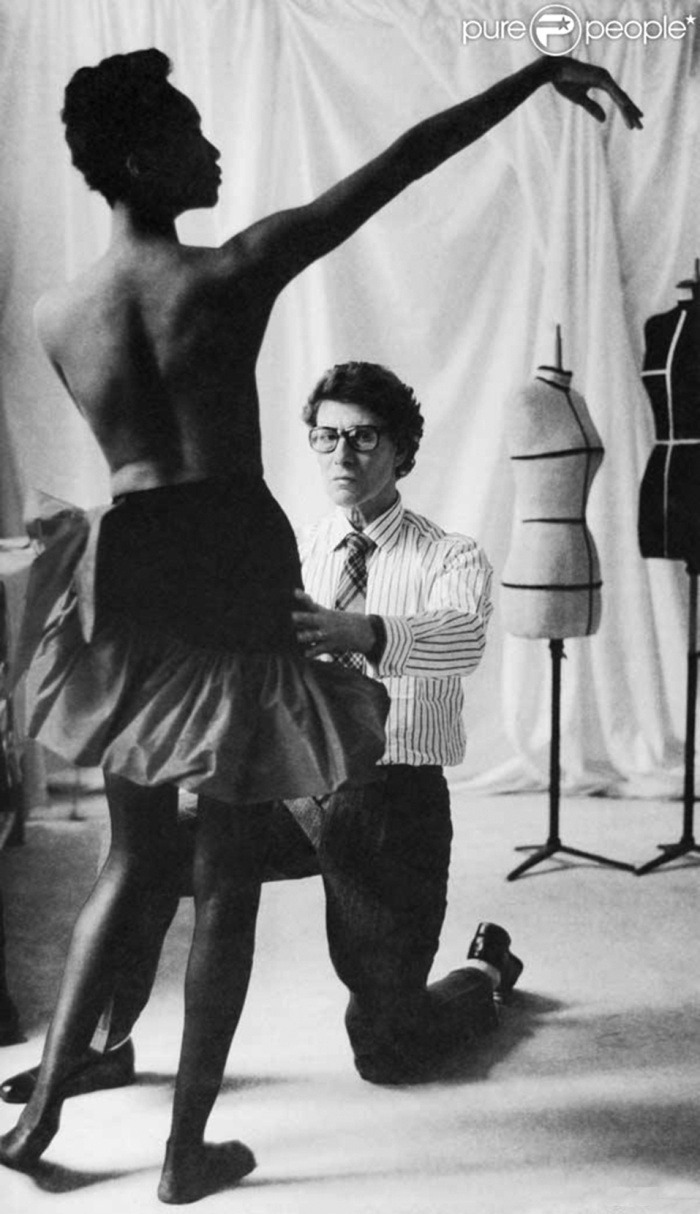
Pic. 11: Yves Saint Laurent with a black model.
Artistic pride and aggressive subculture
Another key reason for radical change in fashion is to be found in artistic pride and conceit, to a large extent parallel to what we encounter in plastic arts and other artistic fields. Previously, clothes were designed for women, yet after the end of the Second World War, in the minds of major fashion designers a concept of “creating” women for clothing has begun, cf. Dukan[3]. The contemporary elites of fashion world are not satisfied with activities such useful and seemingly trivial as dressing women[4]. Their representatives crave to be regarded as real creators and art demiurges wanting to present their works in most prestigious art galleries and playing similar role to that of painters or other visual artists.
Even before, since the end of the First World War, a phenomenon of gradual social and professional transition from tailor-craftsmen into fashion designers occurred. They enjoyed prestige and authority, similar to social role of actors, sometimes even more significant than that of any important artist.
In consciousness of lead fashion designers, as well as in overwhelming majority of homosexuals, a woman lost her significance and became solely a proverbial “coat rack” towards which only expectations are formed: generally those of slenderness, mobility and submissiveness to fashion show’s requirements. All the beauty should beam from the presented creation whereas the smallest flash of model’s character or femineity can outshine the work in an undesirable way. It was chiefly due to this assumption that women curves made it to a black list. It represents deep – on the border of misogyny – contempt towards women:
It is an attempt at depriving women from their beauty, their essence and sexuality as means for receiving fame and credit by the designer as creator of unique work. Everything is accented by homosexual atmosphere that high fashion world is replete with[5].
“To dress a woman, all that she needs is a neck, shoulders and legs. The rest, I will deal with myself” – said Yves Saint Laurent arrogantly once. He was famous for his collaboration with black models (pic. 11) with thin legs, flat bosoms and square-shaped shoulders – the very contradiction to Dior’s sensual woman ideal[6]. Although the ideal of reduced beauty by Yves Saint Laurent was outrageous to some, eventually it won in the fashion community. Coco Chanel, a pioneer of modern fashion dress up (who probably had bisexual tendencies), claimed with indignation that men are set to destroy women, destroy their traditional female forms and change them into young girls:
High fashion is doomed because it is in hands of men who do not like women (…). Men dress up like women, women dress up like men… and nobody is happy with that.
Yet another of her claims made around the same time, even more sinister and, unfortunately, more accurate, is her complaint about not understanding the sixties: “I fully realise that no one is up to date these days”[7]. The legendary fashion designer with all likelihood felt intuitively that such degeneration in the world of fashion in the second half of the 20th century is a parallel process to degeneration in fine arts.
Past adequacy, sophistication of taste and higher class craftsmanship has been replaced with aggression, channelled from the imaginary Olympus high above, the foreground of which is dominated by urge to shock others with something new and extraordinary, as well as a rapid change of trends and fashions, lack of artistry and permanent attacks on traditional culture and human nature. On the other hand, Coco Chanel always promoted reliable craft and skills, protesting loudly every time she was appointed an artist [8]. Contrary to many of her artistic friends – as well as the majority of subsequent fashion designers – Coco was not a rebel and her actions were not destructive in their core. Coco Chanel was obsessed with youth, regarding it as vivid and creative force, not a destructive one. When she dressed the rich in such a way they looked like the poor “she was walking on the thin line above a chasm. Yet, she never failed, because contrary to revolutionists she did not attack the culture”[9].
A typical example of a fashion designer who fund his popularity on the basis of aggressive cultural subversion, especially homosexual, is Jean-Paul Gaultier (born 1952), the uncrowned “king of French fashion”. This “apostle of bad taste”, as he is also called, for three decades has been the most influential fashion designer on the world. Its worldwide, retrospective exhibition has been seen in prestigious galleries by over a million spectators while a number of people attending there exceeded results achieved by leading contemporary and past painters (pic. 12)[10].
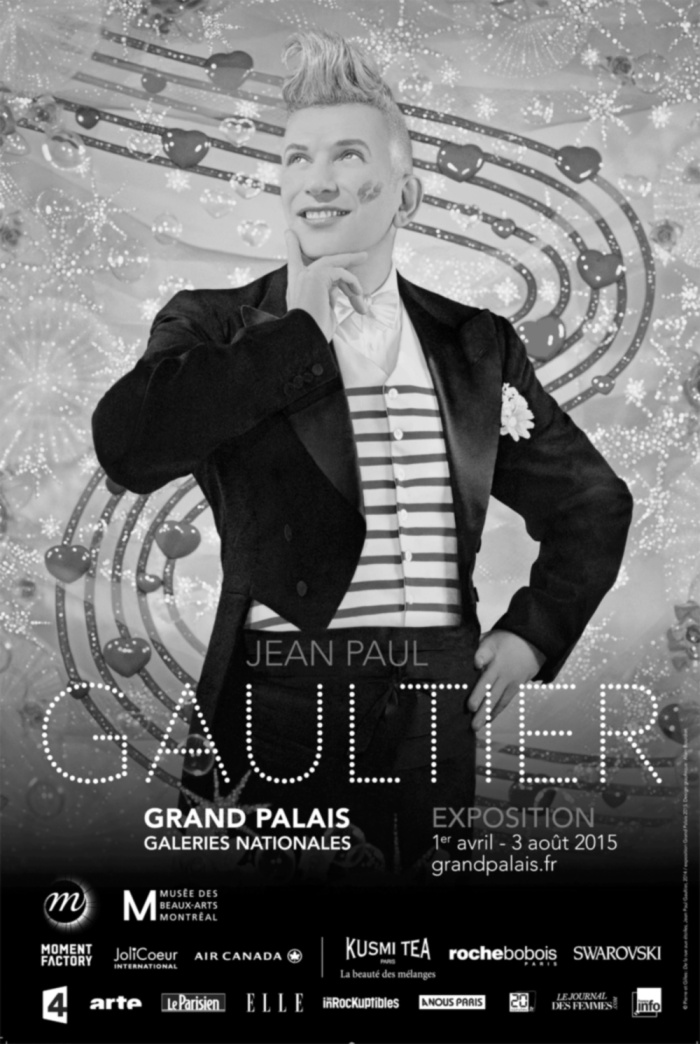
Pic. 12: A poster from Jean-Paul Gaulitier’s exhibition in Grand Palais, Paris.
Gaultier has become known generally for his uncompromising attacks on classical view of female beauty and promoting “gender equality”. As part of this gender swap “game”, he endorsed a provocative, punk and android-like lifestyle with men being endorsed something opposite – they were presented as emasculated and were wearing dresses and corsets. His philosophy and homosexual orientation can be best seen in his example collection Junior from 1988, where famous photograph of Marylin Monroe posing in white dress, blown by the underground fan, is altered so it could fit new homosexual view and fashion trends. If we are to compare Gaultier’s pomadeful hermaphrodites with the photograph from the 1950s, it is becoming clear what kind of world we are currently living in, what kind of world we abandoned in the name of gender ideology and where we are going next (pic. 13).
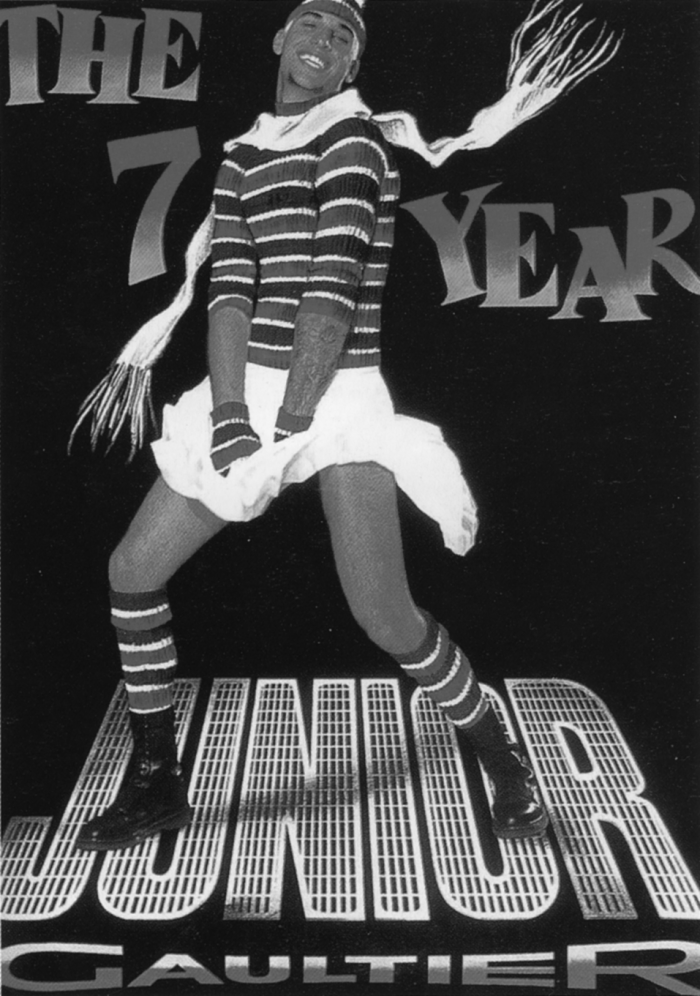
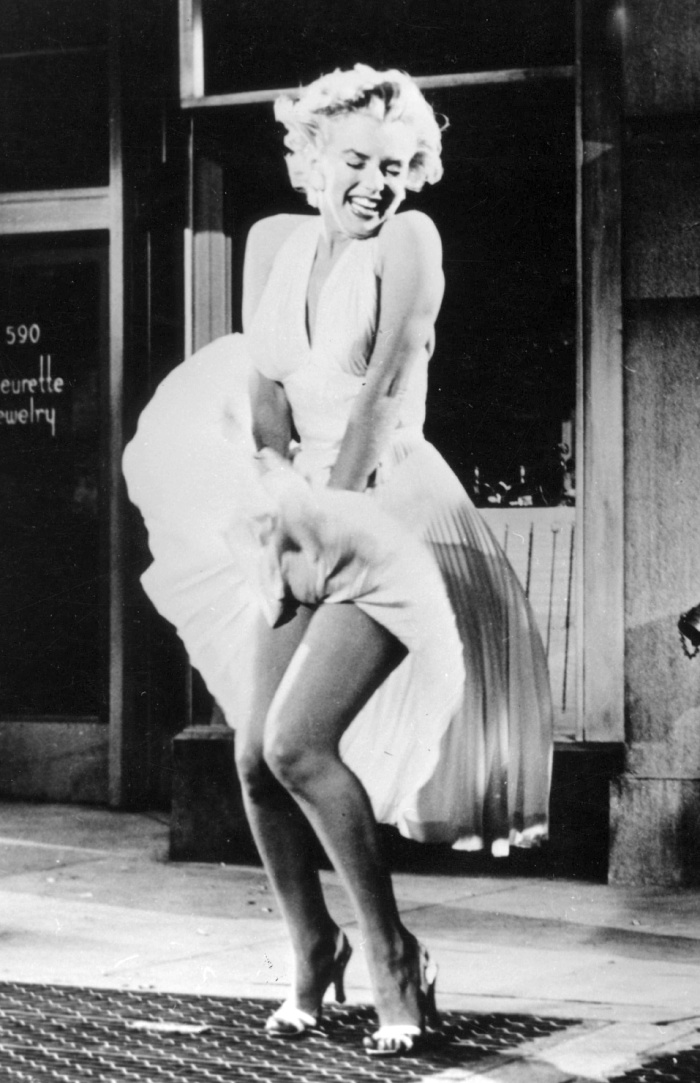
Pic. 13 Now and then. Round curves and natural feminine beauty that attracts male attention. Marilyn Monroe in "The Seven Year Itch" from 1955.
On the right, a postmodern feminine youngster in Junior Gaultier fashion collection advertisement, 1988. Repro: Jana Máchalová: 20th Century Fashion, Lidové noviny 2013, p. 126.
Fashion, homosexualism and running away from nature
This text is not meant to be an attack on homosexuality (understood as congenital sexual disorder). It is to be tolerated, with due contempt towards past excesses connected with repressions of gays and lesbians. The sharp end of this text is pointed towards homosexuality understood as subculture that tries to destroy traditional bonds, morality, as well as traditional aesthetics and the view or perception of surrounding world. (pic. 14). Without a doubt, homosexuality was always present as phenomena and it originates from biological foundation, nevertheless, these foundations are not all there is to see. Its contemporary popularity suggests that something is not quite right here – there has to be more to this game. When the frequency of a phenomena reaches high registers, there has to be a wind blowing from within the culture itself[11].
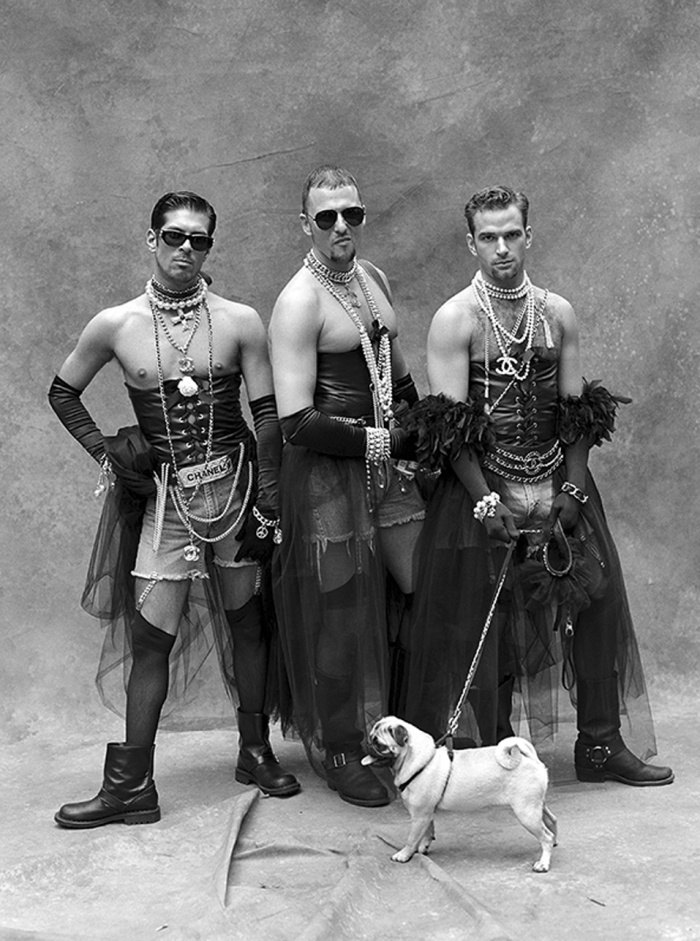
Pic. 14: Michael James O’Brien: "Butch Queens in Chanel",
"Girlfriend" exhibition.
In contemporary society, gender polarity loses its significance – men are becoming emasculated, women are gradually turning into men. If, however, differences between genders become smaller, to the level of a unified android, and eventually they are just a step away from each other, all it takes is this very step and a confused person turns 180 degrees. Especially if the environment is set to convince such a person that the decision is perfectly natural or, as a last resort, trendy. This phenomena is also dangerous and treacherous for heterosexual majority. Will we be able to maintain emotional and sexual bonds if we relentlessly eliminate differences in treating women and men?
Masculinity and femineity represent two distinct poles of behaviour – their manifestation is completely opposing, they are alfa and omega of sexuality. Every attempt at bringing them closer to each other or pacifying their opposability is the best way to cancel their mutual attraction, leading to impotence and indifference [12].
Signals showing that something is amiss are apparent and seen in numbers.
In the first issue of “Contexts” [original: “Kontexty” – translator’s note] from 2015 we published an interesting study of French philosopher, Pierre Manent, entitled Understanding the law again to which I found my thoughts coming back multiple times while writing this text. Regardless of the fact that they were connected with Pierre Manent’s text rather loosely. However, I cannot help myself but to finish this subject with a question. How is it possible for a small number of eccentric LGBT fashion designers to impose their aesthetic preferences on heterosexual majority when they contradict the biological nature so much?
Pierre Manent poses a wider and more general question: how is it even possible that homosexual activists were able to create a situation where they are in control over the entire debate, while their opinions, in reality, are being shared by such a small number of believers? [13] His answer is surprising and ominous, made me really frightened: modernistic project of human world subjectification finds its goal in promoting homosexuality and constitutes its most important gauge. If, for instance, we are to legalise a homosexual relationship and we make it equal to heterosexual relationship, we will reach a human world detached from the natural law, our biological nature, from everything that was before. In the name of false equality and allowing everybody to do almost everything, we are still in denial about privileging the traditional and natural form of intimate symbiosis, in which human being meets another human being in order to form a family capable of procreating and bringing up a new human being, so the continuity of humankind is secured.
Simultaneously, as we learn from anthropologists, the laws concerning marriage and family connections were foundations for the culture and our world. With some complacency we abolished these fundamental laws in order to substitute them with one’s freedom to submit the reality according to one’s bodily desires and creating bonds solely to experience individual pleasure.
The legalising of homosexual marriage (…) becomes a testament to creating of world without rules and measures (proportions).[14]
A conviction that our culture has a patent for truth becomes a ticket to hell, claims Dukan and he is certainly right here. When a culture is coming into too serious conflict with nature then, without a doubt, there is a threat for entire civilisation to collapse. Attempts on discrediting femineity in fashion, suppression of eternal ideal of woman’s beauty and promoting homosexual culture instead are not signs of something harmless, a temporary distortion of taste in a way, but are indications of something far worse. It is a clear symptom of a wide variety of negative cultural influences, telling a lot about our civilisation’s exhaustion [15]. Interestingly, there is not many people who find this worrying.
Excerpt from an article entitled Obrana ženských tvarů
Translation from Czech to Polish: Jarosław Denisiuk
Choice and editing: Jan Tarnas
Pictures available by permission of the author are taken from the original text.
Bio
František Mikš (1966) is a chief editor of Kontexty (www.casopiskontexty.cz ) magazine and chief editor of Books and Pipes publishing. He is an author of many articles and book publications, i.a. Czerwony kogut Picasso Ideologia a utopia w sztuce XX wieku. Od czarnego kwadratu Malewicza do gołąbka pokoju Picassa published by Wydawnictwo M in 2016.
English translation by J. Bujno.
[1] Por. http://en.wikipedia.org/wiki/Category:LGBT_fashion_designers
[2] Por. https://www.amazon.com/Queer-History-Fashion-Closet-Cat%AD-walk/dp/0300196709
[3] Musi być przypis
[4] Dukan, Pierre, op. cit., s. 191.
[5] Dukan, Pierre, op. cit., s. 192.
[6] Levisová, Fiona, op. cit., s. 87–88.
[7] Chaneyová, Lisa, op. cit., s. 366.
[8] Tamże, op. cit, s. 226.
[9] Tamże, op. cit., s 172
[10] Por.: http://www.style.com/trends/industry/2015/jean-paul-gaultier-exhibit-paris.
[11] Dukan, Pierre, op. cit., s. 203.
[12] Dukan, Pierre, op. cit., s. 40
[13] Manent, Pierre: Znovu porozumět zákonu, Kontexty 1/2015, s. 38–43.
[14] Manent, Pierre, op. cit., s. 39-40.
[15] Dukan, Pierre, op. cit., s. 203



